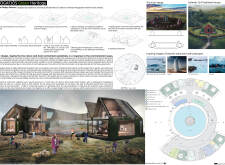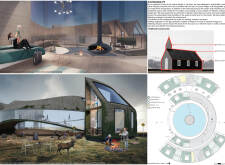5 key facts about this project
The architectural design employs a circular layout, which optimizes views of the surrounding environment and encourages interaction among visitors. The structure features a variety of communal spaces, such as shared kitchens and collaborative work areas, reflecting a modern approach to community building. Emphasis is placed on connecting the architects' vision with the local context, positioning the project as a catalyst for environmental awareness.
The use of materials in VOGAFJÓS is a notable aspect of the design. A combination of wood, stainless steel, glass, volcanic stones, and green vegetation not only adheres to sustainability principles but also enhances the structural and aesthetic qualities of the building. Wood serves as the primary material, chosen for its low environmental impact. Stainless steel provides resilience against Iceland's harsh weather conditions, while glass elements maximize natural light. Volcanic stones are incorporated for their thermal properties, improving energy efficiency. Green vegetation contributes to the building's insulation and strengthens its integration within the site.
The project distinguishes itself from conventional designs through its holistic approach to architecture. By merging traditional building methods with modern sustainable practices, VOGAFJÓS exemplifies a balanced relationship between human habitation and the environment. The emphasis on community through shared spaces and interactive design elements is central to its function. The workflow facilitates direct experiences with nature, enhancing user engagement and promoting a shared understanding of ecological responsibility.
Architectural plans reveal a thoughtful orientation that captures natural light throughout the day, reinforcing the connection to the surrounding landscape. Architectural sections provide insights into the functional distribution of shared spaces, revealing how design facilitates social interaction. Architectural designs focus on eco-friendly materials that support not only the aesthetic vision but also the environmental goals of the project.
This project offers substantial insights into sustainable architecture and serves as a reference point for future developments. For a more detailed understanding of the structural composition and design choices made, you are encouraged to explore the provided architectural plans, sections, and designs.


























